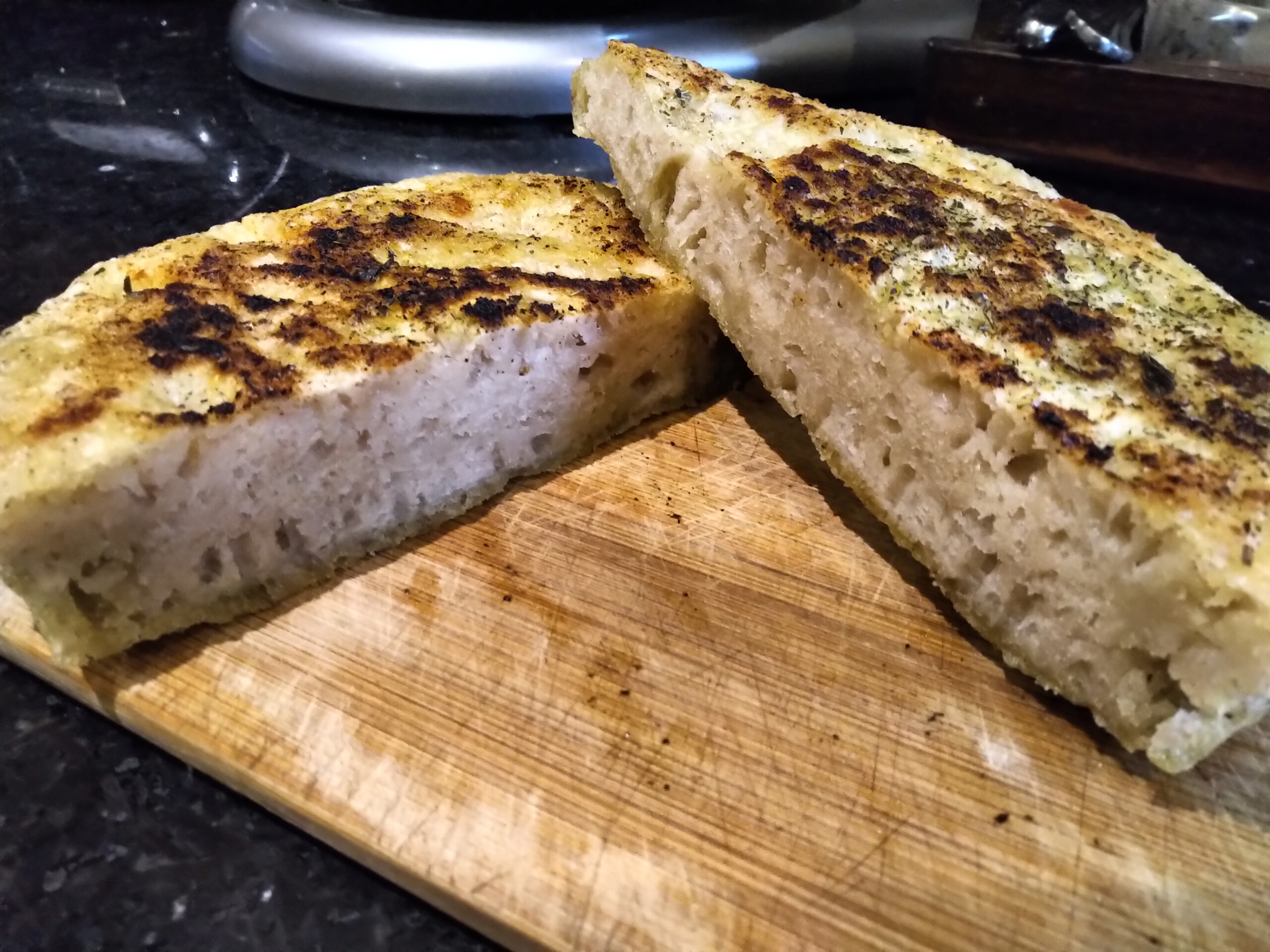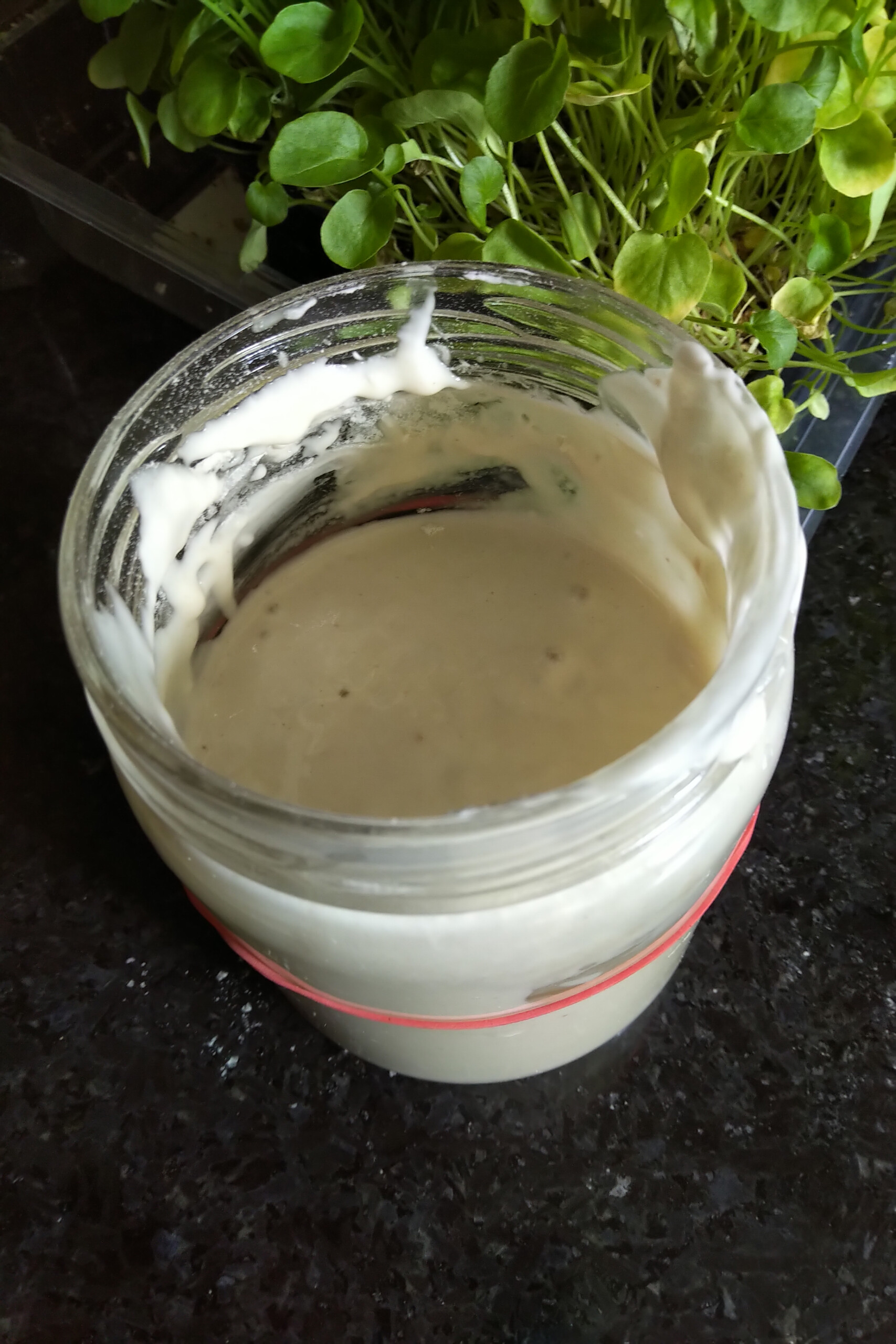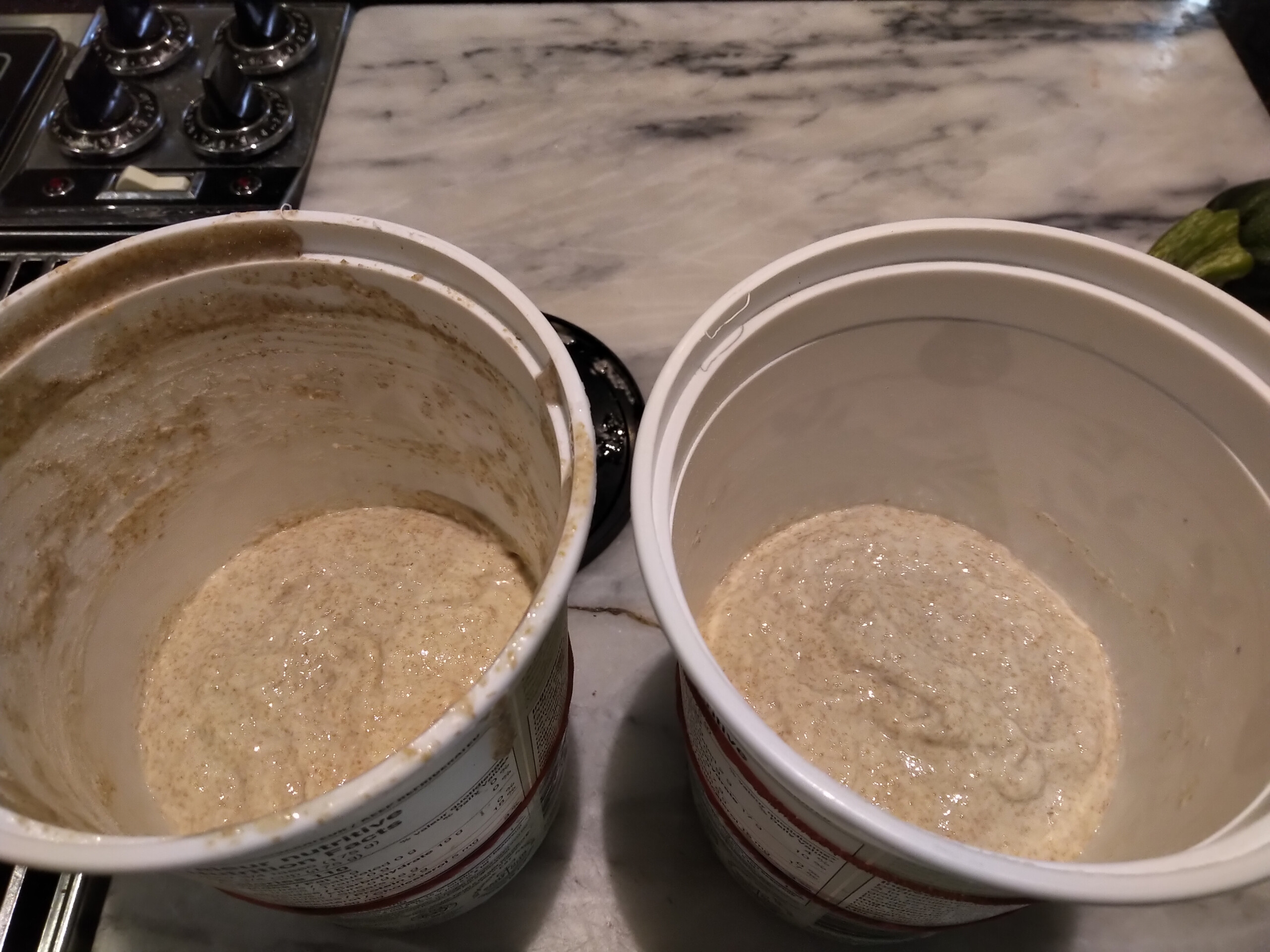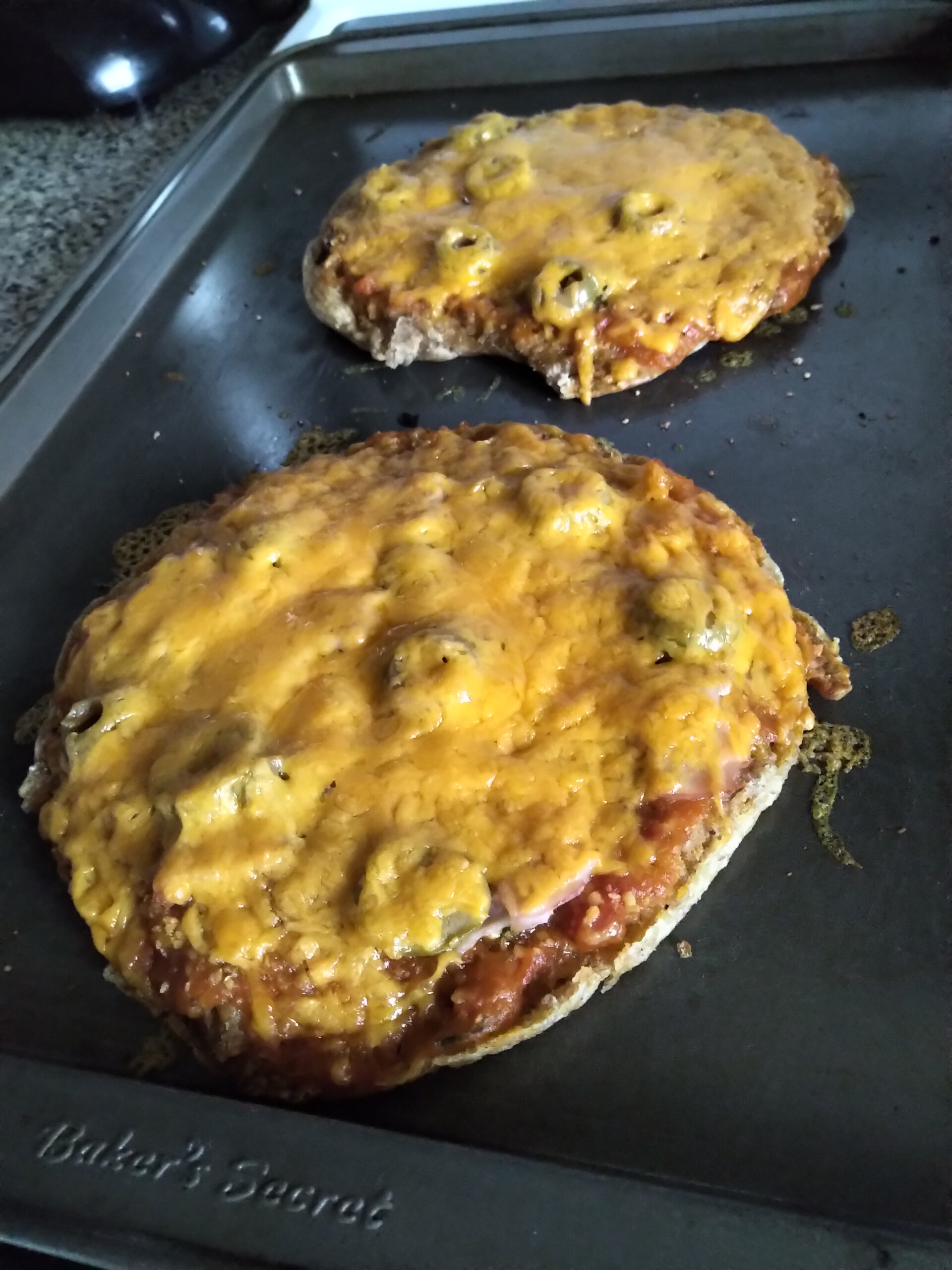 Sourdough bread involves time, work, and timing to taste the delicious loaf whereas this fried fermented bread recipe takes five minutes on either side. Pour, flip, rest then cut.
Sourdough bread involves time, work, and timing to taste the delicious loaf whereas this fried fermented bread recipe takes five minutes on either side. Pour, flip, rest then cut.
When I first discovered that you didn’t ever have to throw out excess sourdough culture, I was ecstatic. Truly grateful for the chefs that thought up fried fermented bread.
First, it was the ease of making Irish Soda Bread, and now a simple delicious fried bread recipe!
Sourdough Culture
Let’s begin at the beginning. If you are reading this post, then you either have a sourdough culture in your possession or you are to get/make some.
Either way, the first step is to grow your sourdough culture or some will say feed it. This is simple. Take your unraised culture…dead in the container (not growing without food) but of course, it is full of lively natural yeasts. It is next to impossible to kill your microbe filled culture unless you dump it into the garbage. I even had mine in the fridge for three months once. The fridge will make it go dormant and when you wish to grow it, you have a little cleaning up to do before you feed it.
With assumptions, it is time to take your culture out of the fridge after being in there for a few days to a week. Whether you have your culture in a glass container or in a plastic yoghurt container, it is all the same. The top layer of the culture will need to be removed. It will look purplish grey. If held longer in the fridge, pour off the liquid then scoop off the top layer. You will notice the difference in colour so now you are on your way to being an expert. Time to feed your culture to make the delicious fried fermented bread recipe.
Feed Your Culture
.5 cup or 125 ml of flour, give or take several grains of flour
.25 cup or 64 ml of water, give or take a few drops
If you are planning to weigh in, then both the water and the flour will weigh the same (100 g each.) As you can read, water is heavier than flour. If the culture is cold from being in the fridge, you may find you need to stir more. If the culture is at room temperature, then stirring will be easier. One of the best pieces of advice was to use a knife or better yet, a good chopstick to stir. The temperature will make a difference in the length of time your culture will take to rise. Put the lids on the top loosely like you are putting them on but not sealing them in place.
On average, it takes approximately 8-12 hours, so you could feed your culture twice a day. I never find a reason to make that much bread. One batch will easily feed two to four people when it is part of a healthy feast.
The amount of culture feed can match the amount of culture in the container (by weight). Best not to have more feed than culture. Your container will be less than half full which leaves room for it to double in size.
Store away in the fridge only to bring it out when you want to make some bread. If culture is in the fridge for a long time, it may require a couple of feedings before making a good rising fried fermented bread.
Other Comments
Most people will use good bread-making flour, mostly white. I go back and forth with red fife and an organic white. It is also said to use a good pinch of rye flour from time to time, and this I have done happily. I use spring water instead of city tap water. Most people I know use filtered water. I cannot speak to the difference the water makes to the culture or the fried fermented bread.
You will notice there are red elastics on the containers. One elastic marks the spot where I have initially fed the culture and the second one will mark when it has doubled in size. Some double and some grow more.
Culture Container
I have read the perfectionist methods of growing culture to chefs that are more relaxed about growing the culture. I have tried both and everything in the middle. For example, should one have a clean vessel after each time you feed your culture? With the rising, the sides do have an amount of sticking culture on them. I have grown my culture a handful of times before I have changed the vessel (glass mason jar or 900 g yoghurt container.)

Fried Fermented Recipe and Instructions
This does not need to be exact nor is it rocket science.
Step One
Select a frying pan that would be able to hold a seven-inch (18 cm) pancake/fried fermented bread. I use a cast iron pan but you can use any pan you have. The only difference is that I have to turn down the stovetop temperature as the cast iron pans get hot.
Step Two
Turn the stove top temperature to medium.
Step Three
When the pan is hot, add some olive oil (or your choice of fat,) a good pinch of salt plus any other seasoning you could imagine (i.e. parsley, rosemary, or paprika.) A person could easily add fried onions to this fried fermented bread recipe.
Step Four
Pour the raised or fed culture into the pan. DO NOT stir the culture…this will deflate the culture. Use a spoon to gently guide out the amount you need which usually means I am left with just enough culture to begin the process all over again. Make sure you leave some culture in the container so you can grow some more. I thank my lucky stars that I have not made this mistake. As soon as you pour the culture into the pan, season the right side up with salt or your choice of seasoning. Try this recipe with salt only until you get the hang of it. Like a pancake, you can watch the air bubbles come to the surface beginning at the edges.
Step Five
After five minutes, flip the bread and let cook for an additional five minutes. If you smell something burning, the stove element may have gotten too hot so turn it down to four or five. With the cast iron, I turn down the element to three.
Step Six
After five minutes, remove the bread to a cutting board and let cool for five to ten minutes. This resting part will make it easier to cut the bread into triangles. You may cut any shape you wish! Break bread with your hands if you wish.
Step Seven
You have a choice to eat plain or put on toppings such as butter. You may have a selection of toppings such as guacamole dip. Most people like it kept simple so for this fried fermented bread recipe, keep plain or add butter.
Fried Fermented Bread Recipe
Voila! You have officially made fried fermented bread. Was it easier than it sounds?
A little less salt or a little more salt? Some like herbs while others do not. Cut the bread in half and make pizzas. This recipe is basic and simple and easy to make.

Enjoy a wedge of fried fermented bread!

Cheryl Millett
Champion for your better health…
Before the age of 20, it never dawned on me that what I chose to put in my mouth would have such a dramatic effect on my wellbeing.
On my path of discovery, I learned that our eating choices directly affected how much energy we have first thing in the morning or that it would build our immune system strength during flu season. Part of it was coming to understand how gentle nutritional cleansing directly helped overcome my health challenges. People keep telling me how beautiful my skin is or how I look younger.
As my studies continued, it became obvious that there is an intrinsic connection between the mind, body, and spirit which directly affects our health and happiness. Omegas are another critical piece of the wellness puzzle. The Auum omegas alone turned on some switches in my brain in just one day.
I have developed a deep appreciation for the wonderful miracle workers our bodies are in the recovery process. Our bodies have natural intelligence. I am passionate to share the connection between nutrition and wellness in my practice and my presentations.






